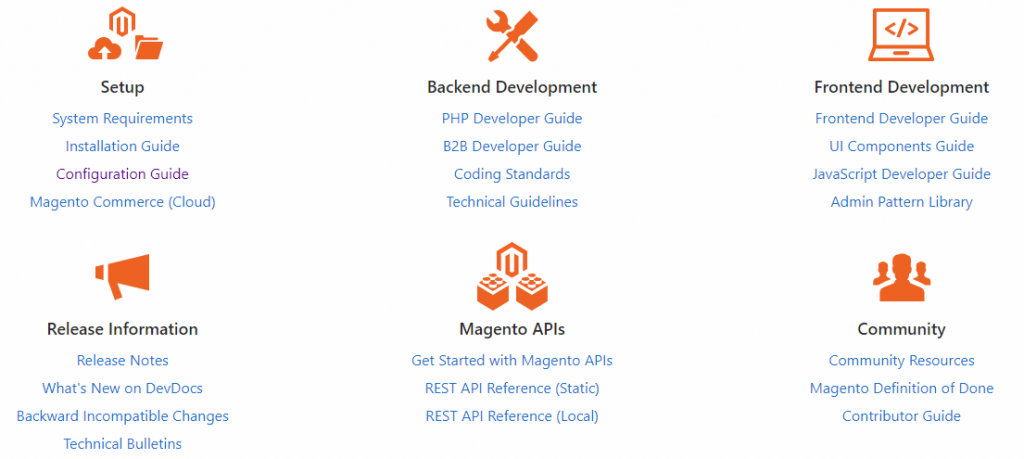Magento Development Documentation
To make any CMS useful it is necessary to maintain an official site. Because the proper documentation of CMS helps open source developers to understand the development environment properly. So, they can maximize the use of CMS and the options. So for the same reason, Magento CE user guide or in another word Magento devdocs is the official site for documentation.
Here open source developers can visit on regular basis for their Magento queries, support and updates etc. Hence we will discuss here the Magento documentation site and use of the site for maximum Magento opportunities.
By the way, the Magento CE user guide or Development Documentation is a source of different technical and coding instruments. So if you’re not good at coding or any have no experience on Magento CMS earlier. In that case, use the source to learn more about Magento from the source as much you can learn. In the meantime, leave the development part to us. As our plus and pro plans include full web development support to our clients around the year. Also, the 24×7 technical and development support is absolutely free of any cost with Mage Cloud Hosting plans!!! Now you can enjoy our Mage cloud hosting plans minimum as USD 7.99 per month.
For Aspiration Hosting – Tanzia Farin Chy
Magento CE user guide – DevDocs
As we can see the Main Top Menu Bar in the following image. Now we will discuss each and every section of the Menu Bar.
Dropdown – Select your Version
By the dropdown Menu, we can select the environment for different Magento version documentation. Simply by choosing a version from the dropdown list works as a filter and show results only for the specific version of Magento.

Setup
Now let’s see, what is setup section is about?
| Installation Guide | Teaches to install Magento CMS using the different method.
|
| Extension Upgrade and System Upgrade Guide | As heading Update and Validation Guidance. |
| Configuration Guide | teaches to configure URLs, DB files etc. |
| Performance Best practice
|
Learn to develop fast loading, user-friendly stores. |
| Migration Guide
|
Teaches to move your DB and store between different servers. |
| Magento Commerce (Cloud) Guide
|
Know about the Magento Cloud. |
| Release Information
|
Mostly release updates and extension’s information. |
Development
First backend: a guide for the backend developers. Mostly the documentation regarding PHP, module, coding, and architecture etc.
Second frontend: a guide for the developer who works in the frontend. Mostly Javascript, style, and UI guidelines.
Final API: Mostly a guide for Web API such as REST API, and SOAP API etc.
Testing
As we already know that Magento has a very user-friendly environment. Hence, it’s the result of tons of code and millions of open source developers. Also, we know that codes like PHP, JavaScript, and web API need functionality testing for bug-free and smooth operations. So, following table is a list of submenu and description of the Testing section.
| Magento Testing Guide | Simply an Introduction to the testing different units. |
| Functional Acceptance Testing (New!) | Learn more about Magento MFTF. Because of MFTF tests designed in XML. So, we do not need Knowledge in PHP anymore. |
| Functional Testing | Teaches the Magento FTF the older testing Framework. |
| Integration Testing | Learn to run integration test using CLI(Command Line Interface) & PHPStrom IDE etc. |
| JavaScript Unit testing
|
Teaches to handle the testing with JS codes. Basically the JS code with Jasmine. |
| PHP Unit Testing | Simply tests the PHP unit using CLI (Command Line Interface). Either using PHPStrom IDE etc. |
| Web API Functional Testing | It allows Magento Web API test from the client’s point of view. |
Functional Areas
However, the functional areas include reporting errors, B2B user guide etc. So, let’s what the section has covered?
Advanced Reporting
By following the path Magento Admin/ Dashboard/ Go to Advanced Reporting buttons. Next, it’ll open a new tab with an authorization of reporting.
B2B Developer
First, the B2B stands for Business to Bussiness model. Hence it means the 1st party as a store admin who is also a seller & 2nd party is a client who accesses the storefronts and buys goods.
Customize Checkout
Simply make the review such as payment information and shipping information.
Payment Integrations
Generally, secure the payment options. And also the placeholder of gateways like debit/credit cards, Paypal etc.
Staging
However, the last functionality offers to us to create different campaigns using our Dashboard.
Tutorials
Finally, we reached the tail of our article this the final section of the tutorials section. So you will be enlightening to hear that Magento CMS offers different video and step by step tutorials in the Magento CE user guides. Also this our final section of the main menu. So, let’s go and take a look at short description following:
How To Guide?
In my sense, the most unique feature Magento has is their feedback service. Because as a developer, you might have tons of tons of questions in your mind to ask from the CMS. And in Magento, you can simply visit GitHub and post your question. Or simply you can email & tweet on Magento Officials. All we can say Magento is a true open source platform.
Order processing with Rest API tutorial
As simple as the name it’s a specific tutorial which is precisely 10 steps. And 30 mins needed to complete the Order processing setup.
All Videos Tutorials
Basically, this is a video tutorial page. But it is very helpful as covers most of the common scenario a beginner wants to learn. For example: Create New page, module, product attribute, the table into DB, and JS module etc.
For further queries upon Magento CE user guide visit Magento official site. Finally, Thank you for reading.

